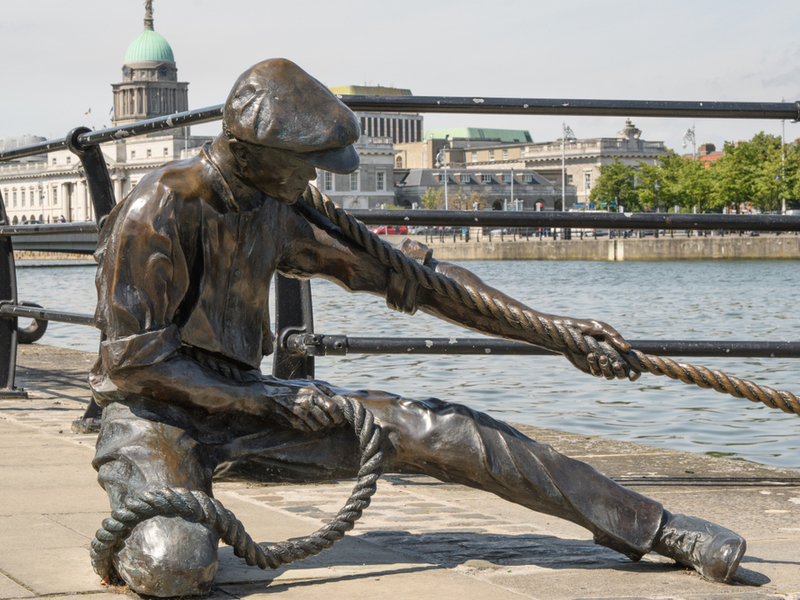A “town centre-first” strategy could prove critical to national recovery, otherwise Ireland risks the untimely death of its once-vibrant town centres.
There have been calls for the creation of an interdepartmental National Town Centre Taskforce to revive urban centres which are being blighted by underused and vacant urban building stocks.
In effect, Irish towns centres are on the verge of no longer being considered “living” towns after businesses lock down their shutters after close of business or failed prospected developments lie idle and unused.
“We surveyed Dundalk and it has a 24pc vacancy rate. Tralee has a 24pc rate. If you get to 40pc your town is dead”
Even before Covid-19, a Town Centre First programme was critically important and urgently needed attention with Irish national commercial vacancy rates at 13.3pc (GeoDirectory). Meanwhile, research from the Parliamentary Budgetary Office, published 28 July, demonstrates that at least 18,000 new homes would become available if vacant properties were activated.
Bring life back to Irish town centres
In a submission to Taoiseach Micheál Martin, Chambers Ireland has urged that a well-resourced Town Centre First programme would serve as a platform for a counter-cyclical economic stimulus – supporting jobs while carrying out much needed public works at a cost-effective point in the economy cycle.
Chambers Ireland CEO Ian Talbot pointed out that an impactful Town Centre First programme would position Ireland to be more competitive, with sustainable housing and resilient local economies and communities, and would allow us to take better advantage of the rebound to the global economy, which may be another three years away.
Talbot pointed out that €10m was earmarked for Town and Village renewal schemes as part of the July Stimulus.
“With 300,000 people living in over 600 small towns and villages this will not have a noticeable impact at the national level, and it neglects the urgent needs of over 3,000,000 people who are living in the urban areas of our cities and towns across every county.
“The Heritage Council’s town centre health checks have demonstrated that our urban spaces are among the least active in Europe. The economic burden of vacancy is felt very heavily in our towns and cities. The Covid-19 crisis is already making the vacancy problem in our town centres worse. Business owners are experiencing significantly reduced footfall and business activity.
“The Programme for Government makes a commitment to a ‘Town Centre First’ approach. If this objective is to be successful it will require the Taoiseach’s leadership and a cross departmental approach. Coordinating the policy activities of the departments of Planning, Housing, Enterprise, Transport and Finance with the actions of Local Authorities is too broad a brief for any one minister and will require the Taoiseach to lead the way if we are to make the necessary changes to change a system that has led to vacancy rates that are far higher than the EU average.
“More attractive urban spaces that support active transport can revive our high streets through supporting increased footfall which leads to higher levels of local spending. Beyond the immediate commercial concerns, making urban living viable will be key to creating sustainable communities that can succeed under the Climate Action Plan.
“There are billions of euros of works which Local Authorities have identified that need to be completed as part of the National Development Plan. Now is the time to make progress,” Talbot said.
A national crisis?
Earlier this year ThinkBusiness spoke to Alison Harvey from the Heritage Council who had been driving the Collaborative Town Centre Health Check (CTHC) Programme.
Harvey said that it is critical we focus on regeneration of town centres to become vibrant hubs for living communities and for conducting business.
Scotland, she pointed out has focused on a strategy of Business Improvement Districts (BIDs) in tandem with EU strategy to improve the trading environment of town/city centres. Under such a scheme building owners pay rates instead of businesses if their buildings are unoccupied. So far Scotland has created 40 BIDs compared with Ireland’s paltry handful (Dublin city, Sligo, Sandyford, Drogheda and Dun Laoghaire).
“There is no national strategy for this, which is not good,” Harvey warned.
At the heart of the issue is building dereliction, flights to the suburbs by former town dwellers and urban planning that has made what were former lived-in, thriving communities, empty shells once businesses close their doors at 6pm.
“What we’re seeing in Ireland isn’t really [urban] planning, it is development. The centres of our towns have lost people to the suburbs or behind and as a result the whole fabric of town centres have frayed and people have forgotten how to live together like they used to.”
The situation isn’t being helped by the rise of online shopping, no doubt spurred on even further by the Covid-19 pandemic as well as the evident drop in footfall because of the crisis and restrictions.
A key indicator to watch is vacancy rates, particularly retail vacancy rates. “The vacancy rate you desire is 4pc, and it is now 5pc in most EU countries,” said Harvey. “We surveyed Dundalk and it has a 24pc vacancy rate. Tralee has a 24pc rate. If you get to 40pc your town is dead.
Ultimately, Harvey said, what is needed is a fresh approach to urban district planning with a focus on quality of life. “We don’t really have a planning system, what we have in reality is a speculative development system. The NAMA Act was created for the best financial return, what we are arguing for is the best economic return.
“We need benchmarking to work out vacancy rates. The European view is if your vacancy rates go over 10pc you have a national crisis. How did we get to this stage?”
Written by John Kennedy (john.kennedy3@boi.com)
Published: 5 August, 2020






